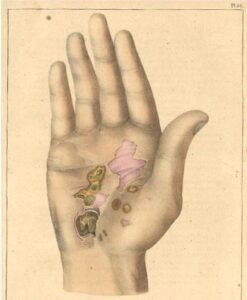“Social” Diseases
Timothy E. Gibbs, M.P.H.
Although the terminology has changed, and the term “venereal disease” is used much less, the Delaware Academy of Medicine possesses several publications detailing historical treatment, diagnosis, and in-depth descriptions of venereal diseases. In the 1990s, these diseases became more commonly referred to as “sexually transmitted diseases.” Today, they are even more broadly known as “sexually transmitted infections.” Venereal diseases are conventionally referred to as syphilis and gonorrhea, and many of the earlier publications in the Academy archives are focused predominately on these two diseases.
Translated from French, Philip Ricord’s publication, “Illustrations of Syphilitic Disease,” comprises colored diagrams, in-depth symptom descriptions, and formularies for recommended traditional remedies (Figure 1). This selected image from Ricord’s compilation was first published in America in 1852 – 164 years ago when syphilis was a significant and essentially untreatable disease. There are four stages of Syphilis: primary, secondary, latent, and tertiary (also known as neurosyphilis). The illustration of a hand (Figure 2) shows secondary, untreated syphilis. The appearance of this rash may be confined to one part of the patient’s body – or spread over many parts. It can vary from rough and scaly to smooth reddish-brown spots. Diagnosis used to be much more challenging as rashes of this type can be caused by other diseases. Fortunately, modern medical diagnosis techniques have advanced significantly, has as our ability to treat secondary infections at the site of rash outbreaks.

Figure 1. Illustrations of Syphilitic Disease, Philip Ricord (trans.)
 Figure 2. Plate XLIV: Pustulo-crustaceous syphilis of the palmar region in various degrees of development. Pustules, crusts, and desquamation
Figure 2. Plate XLIV: Pustulo-crustaceous syphilis of the palmar region in various degrees of development. Pustules, crusts, and desquamation